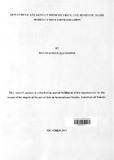| dc.description.abstract | Since the inception of Structural Adjustment Programmes (SAPs) in Africa, debate has raged
on their impact on the various sectors of African economies. Many observers have expressed
doubts on the ability of SAPs to initiate sustainable economic stability, development and
management. However, others have regarded SAPs as a yardstick for development in Africa.
This study is but a contribution to the SAPs debate.
The object of this research project was to establish the changes that took place due to the
liberalization of Kenya's maize market, and how such changes affected the country's food
security. The study was motivated by the lack of systematic analysis on the relationship
between Kenya's food security and the broad framework of structural adjustment
programmes (SAPs).
Since maize is the staple food of Kenya, the study used the crop as a sample to represent
Kenya's food security and tested it against the Cereal Sector Reform Programme (CSRP),
which was initiated in 1986. Narrowed further, the CSRP was represented by one of its
measures, the liberalization of Kenya's matte J;Rarket and the complementary measures that "-
were undertaken to commercialize and eliminate the ~poly of the National Cereals and
Produce Board (NCPB) in maize marketing, storage and distribution.
Chapter I proposes the study by way of introduction and provision of study objectives, the
theoretical framework and hypotheses. Chapter 11 explores food security issues in sub-
Saharan Africa It broadly shades light on the African food situation from political
independence in the early 1960s to the year 2000. It then looks at the issues of food aid as a
solution to food insecurity, vulnerability to food insecurity and the causes of food insecurity
in the sub-Saharan African region. On these issues, it concludes that food aid is not a long-
term solution to Africa's food crisis. It also observes that tacking internal rather than
external constraints could better solve Africa's food crisis.
Chapter III revisits the Kenyan government's food policy with the simple aim of identifying
the changes in policy instruments that the Kenyan government formulated and/or employed
since political independence in 1963. It establishes that although the country operated
without a specific food policy before 1981, the African Socialist paradigm encompassed in
Sessional Paper NO.1 of 1965 catered for the national food needs indirectly.
Chapter IV is an analysis of the price, distributional and other changes that derived from the
liberalization of Kenya's maize market. The study confirms that the liberalization measure
benefited the country substantially by increasing the efficiency of the maize distribution
channels across the country and by narrowing the price differentials between maize deficit
and maize surplus areas
With the aim of measuring the validity of the hypotheses espoused in Chapter I, Chapter V
provides overall conclusions and recommendations derived from the preceding chapters. A
research agenda for the future sums up the study. | en |

